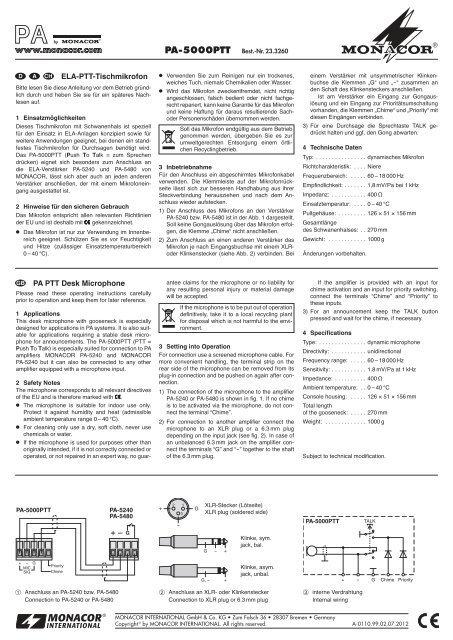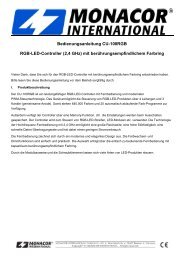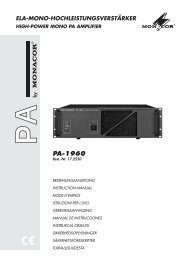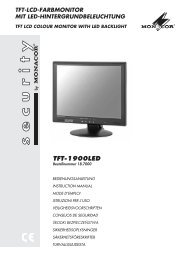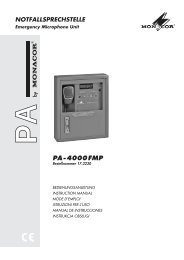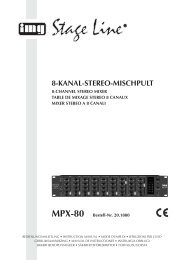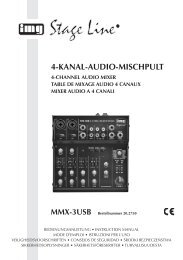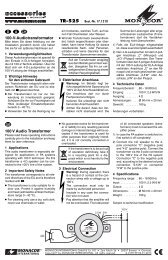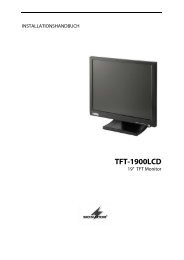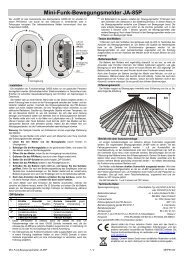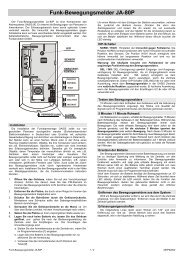PA-5000PTT - Monacor
PA-5000PTT - Monacor
PA-5000PTT - Monacor
Create successful ePaper yourself
Turn your PDF publications into a flip-book with our unique Google optimized e-Paper software.
D A CH<br />
ELA-PTT-Tischmikrofon<br />
Bitte lesen Sie diese Anleitung vor dem Betrieb gründlich<br />
durch und heben Sie sie für ein späteres Nach -<br />
lesen auf.<br />
1 Einsatzmöglichkeiten<br />
Dieses Tischmikrofon mit Schwanenhals ist speziell<br />
für den Einsatz in ELA-Anlagen konzipiert sowie für<br />
weitere Anwendungen geeignet, bei denen ein standfestes<br />
Tisch mikrofon für Durchsagen benötigt wird.<br />
Das <strong>PA</strong>-<strong>5000PTT</strong> (Push To Talk = zum Sprechen<br />
drücken) eignet sich besonders zum Anschluss an<br />
die ELA-Verstärker <strong>PA</strong>-5240 und <strong>PA</strong>-5480 von<br />
MONACOR, lässt sich aber auch an jeden anderen<br />
Verstärker anschließen, der mit einem Mikrofoneingang<br />
ausgestattet ist.<br />
2 Hinweise für den sicheren Gebrauch<br />
Das Mikrofon entspricht allen relevanten Richtlinien<br />
der EU und ist deshalb mit gekennzeichnet.<br />
● Das Mikrofon ist nur zur Verwendung im Innen bereich<br />
geeignet. Schützen Sie es vor Feuchtigkeit<br />
und Hitze (zu lässiger Einsatztemperaturbereich<br />
0 – 40 °C).<br />
<strong>PA</strong> PTT Desk Microphone<br />
GB<br />
Please read these operating instructions carefully<br />
prior to operation and keep them for later reference.<br />
1 Applications<br />
This desk microphone with gooseneck is especially<br />
designed for applications in <strong>PA</strong> systems. It is also suitable<br />
for applications requiring a stable desk microphone<br />
for announcements. The <strong>PA</strong>-<strong>5000PTT</strong> (PTT =<br />
Push To Talk) is especially suited for connection to <strong>PA</strong><br />
amplifiers MONACOR <strong>PA</strong>-5240 and MONACOR<br />
<strong>PA</strong>-5240 but it can also be connected to any other<br />
amplifier equipped with a microphone input.<br />
2 Safety Notes<br />
The microphone corresponds to all relevant directives<br />
of the EU and is therefore marked with .<br />
● The microphone is suitable for indoor use only.<br />
Protect it against humidity and heat (admissible<br />
ambient temperature range 0 – 40 °C).<br />
● For cleaning only use a dry, soft cloth, never use<br />
chemicals or water.<br />
● If the microphone is used for purposes other than<br />
originally intended, if it is not correctly connected or<br />
operated, or not repaired in an expert way, no guar-<br />
<strong>PA</strong>-<strong>5000PTT</strong><br />
+ - G<br />
MIC<br />
SIG<br />
Priority<br />
Chime<br />
➀ Anschluss an <strong>PA</strong>-5240 bzw. <strong>PA</strong>-5480<br />
Connection to <strong>PA</strong>-5240 or <strong>PA</strong>-5480<br />
®<br />
<strong>PA</strong>-5240<br />
<strong>PA</strong>-5480<br />
G<br />
<strong>PA</strong>-<strong>5000PTT</strong> Best.-Nr. 23.3260<br />
● Verwenden Sie zum Reinigen nur ein trockenes,<br />
weiches Tuch, niemals Chemikalien oder Wasser.<br />
● Wird das Mikrofon zweckentfremdet, nicht richtig<br />
angeschlossen, falsch bedient oder nicht fachgerecht<br />
re pa riert, kann keine Garantie für das Mikrofon<br />
und keine Haftung für daraus resultierende Sachoder<br />
Personenschäden übernommen werden.<br />
Soll das Mikrofon endgültig aus dem Be trieb<br />
ge nommen werden, über ge ben Sie es zur<br />
umweltgerechten Entsorgung ei nem ört lichen<br />
Recyc ling betrieb.<br />
3 Inbetriebnahme<br />
Für den Anschluss ein abgeschirmtes Mikrofonkabel<br />
verwenden. Die Klemmleiste auf der Mikrofonrückseite<br />
lässt sich zur besseren Handhabung aus ihrer<br />
Steckverbindung herausziehen und nach dem An -<br />
schluss wieder aufstecken.<br />
1) Der Anschluss des Mikrofons an den Verstärker<br />
<strong>PA</strong>-5240 bzw. <strong>PA</strong>-5480 ist in der Abb. 1 dargestellt.<br />
Soll keine Gongauslösung über das Mikrofon erfolgen,<br />
die Klemme „Chime“ nicht anschließen.<br />
2) Zum Anschluss an einen anderen Verstärker das<br />
Mikrofon je nach Eingangsbuchse mit einem XLRoder<br />
Klinkenstecker (siehe Abb. 2) verbinden. Bei<br />
antee claims for the microphone or no liability for<br />
any resulting personal injury or material damage<br />
will be accepted.<br />
If the microphone is to be put out of oper ation<br />
defin itively, take it to a local recycling plant<br />
for disposal which is not harmful to the environment.<br />
3 Setting into Operation<br />
For connection use a screened microphone cable. For<br />
more convenient handling, the terminal strip on the<br />
rear side of the microphone can be removed from its<br />
plug-in connection and be pushed on again after connection.<br />
1) The connection of the microphone to the amplifier<br />
<strong>PA</strong>-5240 or <strong>PA</strong>-5480 is shown in fig. 1. If no chime<br />
is to be activated via the microphone, do not connect<br />
the terminal “Chime”.<br />
2) For connection to another amplifier connect the<br />
microphone to an XLR plug or a 6.3 mm plug<br />
depending on the input jack (see fig. 2). In case of<br />
an unbalanced 6.3 mm jack on the amplifier connect<br />
the terminals “G” and “-” together to the shaft<br />
of the 6.3 mm plug.<br />
+<br />
2<br />
-<br />
1<br />
3<br />
G<br />
XLR-Stecker (Lötseite)<br />
XLR plug (soldered side)<br />
G -<br />
G, -<br />
+<br />
+<br />
Klinke, sym.<br />
jack, bal.<br />
Klinke, asym.<br />
jack, unbal.<br />
➁ Anschluss an XLR- oder Klinkenstecker<br />
Connection to XLR plug or 6.3 mm plug<br />
einem Verstärker mit unsymmetrischer Klinkenbuchse<br />
die Klemmen „G“ und „-“ zusammen an<br />
den Schaft des Klinkensteckers an schließen.<br />
Ist am Verstärker ein Eingang zur Gongaus -<br />
lösung und ein Eingang zur Prioritätsumschaltung<br />
vorhanden, die Klemmen „Chime“ und „Priority“ mit<br />
diesen Eingängen verbinden.<br />
3) Für eine Durchsage die Sprechtaste TALK ge -<br />
drückt halten und ggf. den Gong abwarten.<br />
4 Technische Daten<br />
Typ: . . . . . . . . . . . . . . . . dynamisches Mikrofon<br />
Richtcharakteristik: . . . . Niere<br />
Frequenzbereich: . . . . . 60 – 18 000 Hz<br />
Empfindlichkeit: . . . . . . . 1,8 mV/Pa bei 1 kHz<br />
Impedanz: . . . . . . . . . . . 400 Ω<br />
Einsatztemperatur: . . . . 0 – 40 °C<br />
Pultgehäuse: . . . . . . . . . 126 × 51 × 156 mm<br />
Gesamtlänge<br />
des Schwanenhalses: . . 270 mm<br />
Gewicht: . . . . . . . . . . . . 1000 g<br />
Änderungen vorbehalten.<br />
If the amplifier is provided with an input for<br />
chime activation and an input for priority switching,<br />
connect the terminals “Chime” and “Priority” to<br />
these inputs.<br />
3) For an announcement keep the TALK button<br />
pressed and wait for the chime, if necessary.<br />
4 Specifications<br />
Type: . . . . . . . . . . . . . . . dynamic microphone<br />
Directivity: . . . . . . . . . . . unidirectional<br />
Frequency range: . . . . . 60 – 18 000 Hz<br />
Sensitivity: . . . . . . . . . . . 1.8 mV/Pa at 1 kHz<br />
Impedance: . . . . . . . . . . 400 Ω<br />
Ambient temperature: . . 0 – 40 °C<br />
Console housing: . . . . . 126 × 51 × 156 mm<br />
Total length<br />
of the gooseneck: . . . . . 270 mm<br />
Weight: . . . . . . . . . . . . . 1000 g<br />
Subject to technical modification.<br />
<strong>PA</strong>-<strong>5000PTT</strong><br />
➂ interne Verdrahtung<br />
Internal wiring<br />
+<br />
-<br />
TALK<br />
G<br />
Chime Priority<br />
MONACOR INTERNATIONAL GmbH & Co. KG Zum Falsch 36 28307 Bremen Germany<br />
Copyright © by MONACOR INTERNATIONAL. All rights reserved. A-0110.99.02.07.2012
F B CH<br />
Microphone de table<br />
Public Adress PTT<br />
Veuillez lire la présente notice avec attention avant le<br />
fonctionnement et conservez-la pour pouvoir vous y<br />
reporter ultérieurement.<br />
1 Possibilités dʼutilisation<br />
Ce micro de table avec col de cygne est spécialement<br />
conçu pour une utilisation dans des installations de<br />
Public Adress et tout autre type dʼutilisations nécessitant<br />
un micro de table fixe pour effectuer des annonces.<br />
Le <strong>PA</strong>-<strong>5000PTT</strong> (PTT = Push To Talk = appuyer pour<br />
parler) sʼadapte très bien à un branchement sur les<br />
amplificateurs Public Adress <strong>PA</strong>-5240 et <strong>PA</strong>-5480 de<br />
MONACOR, il peut également se brancher sur tout<br />
autre amplificateur doté dʼune entrée micro.<br />
2 Conseils dʼutilisation et de sécurité<br />
Le microphone répond à toutes les directives nécessaires<br />
de lʼUnion Européenne et porte donc le symbole<br />
.<br />
● Le micro nʼest conçu que pour une utilisation en<br />
intérieur. Protégez-le de lʼhumidité et de la chaleur<br />
(plage de température de fonctionnement autorisée<br />
: 0 °C à +40 °C)<br />
Microfono <strong>PA</strong> PTT da tavolo<br />
I<br />
Vi preghiamo di leggere attentamente le presenti istruzioni<br />
prima della messa in funzione e di conservarle<br />
per un uso futuro.<br />
1 Possibilità dʼimpiego<br />
Questo microfono da tavolo con collo di cigno è stato<br />
realizzato specialmente per lʼimpiego in impianti<br />
<strong>PA</strong> nonché per quelle applicazioni in cui è richiesto un<br />
microfono per avvisi su base solida. Il <strong>PA</strong>-<strong>5000PTT</strong><br />
(Push To Talk = premere per parlare) è particolarmen -<br />
te adatto per il collegamento con gli amplificatori<br />
<strong>PA</strong>-5240 e <strong>PA</strong>5480 della MONACOR, ma può essere<br />
collegato con un qualsiasi altro amplificatore equipag -<br />
giato con ingresso microfono.<br />
2 Avvertenze di sicurezza<br />
Il microfono è conforme a tutte le direttive rilevanti dellʼUE<br />
e pertanto porta la sigla .<br />
● Il microfono è previsto solo per lʼuso allʼinterno di<br />
locali. Proteggerlo dallʼumidità dellʼaria e dal calore<br />
(temperatura dʼimpiego ammessa fra 0 e 40° C.).<br />
● Per la pulizia usare solo un panno morbido, asciut -<br />
to; non impiegare in nessun caso prodotti chimici o<br />
acqua.<br />
<strong>PA</strong>-<strong>5000PTT</strong><br />
+ - G<br />
MIC<br />
SIG<br />
Priority<br />
Chime<br />
<strong>PA</strong>-5240<br />
<strong>PA</strong>-5480<br />
➀ Branchement au <strong>PA</strong>-5240/<strong>PA</strong>-5480<br />
Connessione con <strong>PA</strong>-5240 o <strong>PA</strong>-5480<br />
®<br />
G<br />
<strong>PA</strong>-<strong>5000PTT</strong> Best.-Nr. 23.3260<br />
● Pour le nettoyer, utilisez un chiffon sec et doux, en<br />
aucun cas de produits chimiques ou dʼeau.<br />
● Nous déclinons toute responsabilité en cas de dommages<br />
corporels ou matériels résultants si le micro<br />
est utilisé dans un but autre que celui pour lequel il<br />
a été conçu, sʼil nʼest pas correctement branché,<br />
utilisé ou nʼest pas réparé par une personne habilitée<br />
; de même, la garantie deviendrait caduque.<br />
Lorsque le micro est définitivement retiré du<br />
marché, vous devez le déposer dans une<br />
usine de recyclage de proximité pour contribuer<br />
à son élimination non polluante.<br />
3 Mise en service<br />
Utilisez un câble micro blindé pour le branchement. Il<br />
est possible de retirer la barrette de connexion de son<br />
emplacement sur la face arrière du micro pour faciliter<br />
la manipulation du micro et une fois les branchements<br />
effectués, de la replacer.<br />
1) Le schéma 1 présente le branchement du micro à<br />
lʼamplificateur <strong>PA</strong>-5240/<strong>PA</strong>-5480. Si le gong ne<br />
doit pas être déclenché via le micro, ne connectez<br />
pas la borne “Chime”.<br />
2) Pour une connexion à un autre amplificateur,<br />
connectez le micro selon la prise dʼentrée, à une<br />
● Nel caso dʼuso improprio, di collegamenti sbagliati,<br />
dʼimpiego scorretto o di riparazione non a regola<br />
dʼarte non si assume nessuna responsabilità per<br />
eventuali danni a persone o a cose.<br />
Se si desidera eliminare il microfono definitivamente,<br />
consegnarlo per lo smaltimento ad<br />
unʼistituzione locale per il riciclaggio.<br />
3 Messa in funzione<br />
Per il collegamento usare un cavo schermato per<br />
microfoni. Per maggiore comodità, la morsettiera sul<br />
retro del microfono è sfilabile dal connettore e può<br />
essere rimessa a connessione terminata.<br />
1) La connessione del microfono con lʼamplificatore<br />
<strong>PA</strong>-5240 o <strong>PA</strong>-5480 è rappresentata in fig. 1. Se il<br />
microfono non deve attivare il gong non è necessario<br />
collegare il morsetto “Chime”.<br />
2) Usando un altro amplificatore, collegare il<br />
microfono utilizzando un connettore XRL o jack a<br />
seconda della presa dʼingresso (vedi fig. 2). Se si<br />
tratta di una presa jack asimmetrica sullʼamplificatore<br />
occorre collegare i morsetti “G” e “-” insieme<br />
con il gambo del jack.<br />
+<br />
2<br />
-<br />
1<br />
3<br />
G<br />
fiche XLR (côté soudé)<br />
connettore XLR (lato saldatura)<br />
G -<br />
G, -<br />
+<br />
+<br />
jack, sym.<br />
jack, simm.<br />
jack, asym.<br />
jack, asimm.<br />
➁ Branchement à la fiche XLR ou à la fiche jack<br />
Connessione con connettore XLR o jack<br />
fiche XLR ou une fiche jack (voir schéma 2). Dans<br />
le cas dʼune prise jack asymétrique sur lʼamplificateur,<br />
connectez les bornes “G” et “-” ensemble au<br />
corps de la fiche jack.<br />
Si lʼamplificateur est doté dʼune entrée pour le<br />
déclenchement du gong et dʼune entrée pour la<br />
commutation prioritaire, reliez les bornes “Chime”<br />
et “Priority” à ces entrées.<br />
3) Pour une annonce, maintenez la touche TALK en -<br />
foncée et si nécessaire attendez le gong.<br />
4 Caractéristiques techniques<br />
Type : . . . . . . . . . . . . . . micro dynamique<br />
Caractéristique : . . . . . . unidirectionnel<br />
Bande passante : . . . . . 60 – 18 000 Hz<br />
Sensibilité : . . . . . . . . . . 1,8 mV/Pa à 1 kHz<br />
Impédance : . . . . . . . . . 400 Ω<br />
Température fonc. : . . . . 0 – 40 °C<br />
Boîtier pupitre : . . . . . . . 126 × 51 × 156 mm<br />
Longueur totale<br />
du col de cygne : . . . . . . 270 mm<br />
Poids : . . . . . . . . . . . . . . 1000 g<br />
Tout droit de modification réservé.<br />
Se lʼamplificatore presenta un ingresso per attivare<br />
il gong e un ingresso per commutare la priorità,<br />
si deve collegare i morsetti “Chime” e “Priority”<br />
con detti ingressi.<br />
3) Per effettuare un avviso, tener premuto il tasto<br />
TALK ed aspettare eventualmente il gong.<br />
4 Dati tecnici<br />
Tipo: . . . . . . . . . . . . . . . microfono dinamico<br />
Caratteristica: . . . . . . . . a cardioide<br />
Gamma di frequenze: . . 60 – 18 000 Hz<br />
Sensibilità: . . . . . . . . . . . 1,8 mV/Pa a 1 kHz<br />
Impedenza: . . . . . . . . . . 400 Ω<br />
Temperatura dʼimpiego . 0 – 40 °C<br />
Contenitore: . . . . . . . . . 126 × 51 × 156 mm<br />
Lunghezza totale<br />
del collo di cigno: . . . . . 270 mm<br />
Peso: . . . . . . . . . . . . . . . 1000 g<br />
Con riserva di modifiche tecniche.<br />
<strong>PA</strong>-<strong>5000PTT</strong><br />
➂ Câblage interne<br />
Cablaggio interno<br />
+<br />
-<br />
TALK<br />
G<br />
Chime Priority<br />
MONACOR INTERNATIONAL GmbH & Co. KG Zum Falsch 36 28307 Bremen Germany<br />
Copyright © by MONACOR INTERNATIONAL. All rights reserved. A-0110.99.02.07.2012
E<br />
Micro de mesa Public Adress PTT<br />
Lea atentamente las instrucciones de funcionamiento<br />
antes de utilizar el aparato y guárdelas para usos posteriores.<br />
1 Posibilidades de utilización<br />
Este micro de mesa con cuello de cisne está especialmente<br />
fabricado para una utilización en sistemas<br />
de Public Address y todo otro tipo de utilizaciones que<br />
necesiten un micro de mesa fijo para efectuar anuncios.<br />
El <strong>PA</strong>-<strong>5000PTT</strong> (PTT = Push To Talk = pulse<br />
para hablar) se adapta muy bien a una conexión en<br />
amplificadores Public Address <strong>PA</strong>-5240 y <strong>PA</strong>-5480 de<br />
MONACOR, puede también conectarse en otros<br />
amplificadores si disponen de una entrada de micro.<br />
2 Consejos de utilización y seguridad<br />
El micro cumple con todas las directivas relevantes de<br />
la UE y por lo tanto está marcado con el símbolo .<br />
● El micro está fabricado para una utilización en interior.<br />
Protéjelo de la humedad y del calor (temperatura<br />
de funcionamiento autorizada: 0 °C a +40 °C)<br />
● Para limpiarlo, utilice un trapo seco y suave, en<br />
ningún caso productos químicos o agua.<br />
<strong>PA</strong>-<strong>5000PTT</strong><br />
PL<br />
Przed przystąpieniem do użytkowania urządzenia<br />
prosimy zapoznać się z instrukcją obsługi, a następnie<br />
zachować ją do wglądu.<br />
1 Zastosowanie<br />
Mikrofon pulpitowy na gęsiej szyi jest przeznaczony<br />
przede wszystkim do zastosowań w systemach ra diowęzłowych.<br />
Jest również przeznaczony do zastosowań<br />
wymagających mikrofonu pulpitowego do wygłaszania<br />
zapowiedzi. Mikrofon <strong>PA</strong>-<strong>5000PTT</strong> (PTT=<br />
Push To Talk) nadaje się głównie do podłą czania do<br />
wzmacniaczy firmy MONACOR o symbolach <strong>PA</strong>-<br />
5240, czy <strong>PA</strong>-5480, ale może być także podłą czony<br />
do jakiegokolwiek wzmacniacza wypo sażo nego w<br />
wejście mikrofonowe.<br />
2 Noty Bezpieczeństwa<br />
Mikrofon spełnia wszystkie wymagania norm UE,<br />
dzięki czemu zostało oznaczone symbolem .<br />
● Mikrofon jest przeznaczony do używania w pomie -<br />
szczeniach zamkniętych. Należy chronić go przed<br />
wilgocią i gorącem (dopuszczalny zakres temperatury<br />
otoczenia pracy wynosi 0 – 40 °C).<br />
● Do czyszczenia używać jedynie suchych, czystych<br />
kawałków. Nie wolno używać żadnych środków<br />
chemicznych, ani wody.<br />
<strong>PA</strong>-<strong>5000PTT</strong><br />
+ - G<br />
MIC<br />
SIG<br />
Priority<br />
Chime<br />
<strong>PA</strong>-5240<br />
<strong>PA</strong>-5480<br />
➀ Conexión al <strong>PA</strong>-5240/<strong>PA</strong>-5480<br />
Podłączanie do <strong>PA</strong>-5240 lub <strong>PA</strong>-5480<br />
®<br />
G<br />
<strong>PA</strong>-<strong>5000PTT</strong> Best.-Nr. 23.3260<br />
● Rechazamos toda responsabilidad en caso de<br />
daños corporales o materiales si el micro se utiliza<br />
en otro fin para el cual ha sido fabricado, si no está<br />
correctamente conectado, utilizado o si no está<br />
reparado por una persona habilitada; por estos<br />
mismos motivos el aparato carecería de todo tipo<br />
de garantía.<br />
Cuando el micro está definitivamente sa cado<br />
del servicio, debe depositarlo en una fábrica<br />
de reciclaje de proximidad para contribuir a<br />
una eliminación no contaminante.<br />
3 Puesta en marcha<br />
Utilice un cable micro blindado para la conexión. Es<br />
posible sacar la barreta de conexión de la parte trasera<br />
del micro para facilitar la manipulación del micro, y una<br />
vez las conexiones efectuadas colocarla de nuevo.<br />
1) El esquema 1 presenta la conexión del micro al<br />
amplificador <strong>PA</strong>-5240/<strong>PA</strong>-5480. Si la conexión del<br />
gong vía el micro no debe efectuarse, no conecte<br />
el borne “Chime”.<br />
2) Para una conexión a otro amplificador, conecte el<br />
micro según la toma de entrada, a una toma XLR o<br />
una toma jack (vea esquema 2). En el caso de una<br />
● Jeżeli urządzenie jest używane do innych niż<br />
wskazane celów, jest nieprawidłowo podłączone,<br />
obsługiwane w niewłaściwy sposób lub jest na prawiane<br />
przez niewykwalifikowane osoby, żadne<br />
roszczenia gwarancyjne, ani roszczenia wynikające<br />
z uszczerbku zdrowia lub zniszczenia mienia<br />
nie będą akceptowane.<br />
Jeżeli urządzenie nie będzie więcej używane<br />
należy je utylizować zgodnie z przepisami<br />
dotyczącymi ochrony środowiska.<br />
3 Uruchomienie i Obsługa<br />
Do podłączenia mikrofonu należy używać ekranowanego<br />
kabla mikrofonowego. Dla udogodnienia taśma<br />
terminala może być odłączona od gniazda w tylnej<br />
części mikrofonu i podłączona ponownie po połącz -<br />
eniu przewodów.<br />
1) Sposób podłączenia mikrofonu do wzmacniacza<br />
<strong>PA</strong>-5240, czy <strong>PA</strong>-5480 jest pokazana na rys. 1.<br />
Jeżeli gong nie ma być włączany za pomocą mikrofonu,<br />
nie należy podłączać złącza oznaczonego<br />
jako “Chime”.<br />
2) W celu podłączenia mikrofonu do innego wzmacniacza<br />
należy w zależności od wejścia mikrofonowego<br />
wzmacniacza użyć złącza XLR lub jacka<br />
6,3 mm (rys. 2). W przypadku, gdy wejście mikrofo-<br />
+<br />
2<br />
-<br />
1<br />
3<br />
G<br />
toma XLR (lado soldado)<br />
wtyk XLR (widok z tytu)<br />
G -<br />
G, -<br />
+<br />
+<br />
jack, sim.<br />
jack, zbal.<br />
jack, asim.<br />
jack, niezbal.<br />
➁ Conexión con la toma XLR o toma jack<br />
Podłączanie do wtyku XLR lub jacka<br />
toma jack asimétrica en el amplificador, conecte<br />
los bornes “G” y “-” junto al cuerpo de la ficha jack.<br />
Si el amplificador dispone de una entrada para<br />
la detección del gong y de una entrada para la conmutación<br />
prioritaria, conecte los bornes “Chime” y<br />
“Priority” a esta entradas.<br />
3) Para un anuncio, mantenga la tecla TALK pulsada<br />
y si necesario espere el gong.<br />
4 Características técnicas<br />
Tipo: . . . . . . . . . . . . . . . micro dinámico<br />
Característica: . . . . . . . . unidireccional<br />
Gama de frecuencias: . . 60 – 18 000 Hz<br />
Sensibilidad: . . . . . . . . . 1,8 mV/Pa a 1 kHz<br />
Impedancia: . . . . . . . . . 400 Ω<br />
Temperatura func.: . . . . 0 – 40 °C<br />
Recinto sobre mesa: . . . 126 × 51 × 156 mm<br />
Longitud total<br />
del cuello de cisne: . . . . 270 mm<br />
Peso: . . . . . . . . . . . . . . . 1000 g<br />
Sujeto a modificaciones técnicas.<br />
nowe wzmacniacza jest niezbalansowane należy<br />
podłączyć terminal “G” i “-” równocześnie do masy<br />
jacka 6,3 mm.<br />
Jeżeli wejście wzmacniacza jest przystosowane<br />
do sterowania gongiem poprzez mikrofon należy<br />
podłączyć końcówki “Chime” i “Priority” do tego<br />
wejścia.<br />
3) Żeby włączyć mikrofon w tryb zapowiedzi, należy<br />
wcisnąć i przytrzymać przycisk mikrofonowy oraz<br />
w razie konieczności poczekać aż odegrany zos tanie<br />
sygnał gongu.<br />
4 Dane Techniczne<br />
Typ: . . . . . . . . . . . . . . . . mikrofon dynamiczny<br />
Charakterystyka: . . . . . . okólna<br />
Zakres częstotliwości: . . 60 – 18 000 Hz<br />
Czułość: . . . . . . . . . . . . 1,8 mV/Pa przy 1 kHz<br />
Impedancja: . . . . . . . . . 400 Ω<br />
Temperatura<br />
otoczenia pracy: . . . . . . 0 – 40 °C<br />
Wymiary obudowy: . . . . 126 × 51 × 156 mm<br />
Całkowita długość<br />
gęsiej szyi: . . . . . . . . . . 270 mm<br />
Waga: . . . . . . . . . . . . . . 1000 g<br />
Z zastrzeżeniem możliwości zmian.<br />
<strong>PA</strong>-<strong>5000PTT</strong><br />
➂ Cableado interno<br />
Schemat wewnętrzny<br />
+<br />
-<br />
TALK<br />
G<br />
Chime Priority<br />
MONACOR INTERNATIONAL GmbH & Co. KG Zum Falsch 36 28307 Bremen Germany<br />
Copyright © by MONACOR INTERNATIONAL. All rights reserved. A-0110.99.02.07.2012


